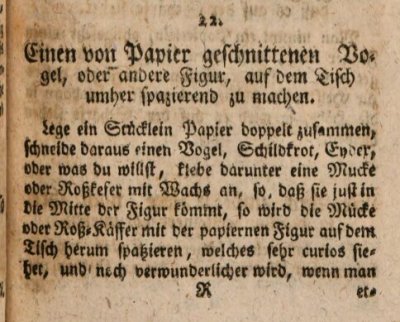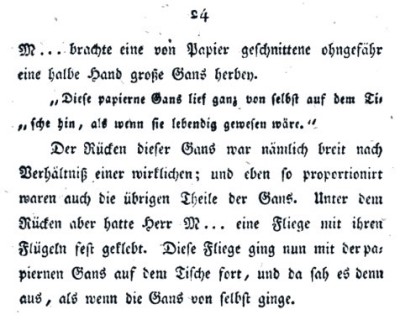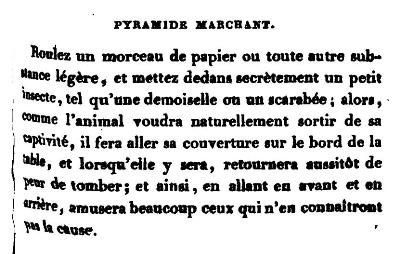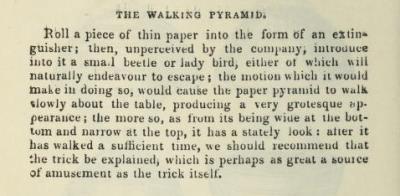| The Public Paperfolding History Project
Last updated 7/4/2024 x |
|||||||
| Designs which Move under Insect Power | |||||||
| This
page attempts to record what is known about the origin
and history of paperfoding designs which move under
insect power. Please contact me if you know any of this
information is incorrect or if you have any other
information that should be added. Thank you. ********** 1762 Part 4 of 'Die Zehenmal Hundert und Eine Kunst' by Albrecht Ernst Friedrich von Crailsheim, which was published in 1762, contains whatis possibly the earliest reference to Fodand Cut Animals (although the reference is not completely clear). The text below says, roughly, 'Fold a piece of paper in two, then cut out a bird, a turtle, or whatever you like and glue a fly in the middle of it with wax ...', the idea being that the the bird or turtle etc then appears to walk around the table under fly power. The text also mentions the possibility of doing this with two other kinds of insects a 'Rossteser' (meaning unknown) or a 'rote Käfer' (red beetle).
********** 1817 In Volume 1 of 'Der magische Jugendfreund' by Johann Heinrich Moritz von Poppe, which was published in Frankfurt in 1817 the author describes a 'paper-cut goose' whose 'back was broad in proportion to a real one, and the other parts of the goose were also properly prepared' under which 'Herr M had glued a fly by its wings. This fly went away with the paper goose on the table and then it looked as if the goose was going by itself'.
********** 1828 A similar stunt appears, as 'The Moving Pyramid' in 'The Boy's Own Book' by William Clarke, which was was published by Vizetelly, Branston and Company in London in 1828.
********** 1831 Volume 2 of 'Manuel des Jeunes Gens', which was published in Paris by Librairie Encyclopedique de Roret in Paris in 1931 contains a similar mention of a 'Pyramide Marchant'.
********** 1844 And also as 'The Walking Pyramid' in 'The Boy's Holyday Book', which was published by G H Davidson in London around 1844.
********** |
|||||||






